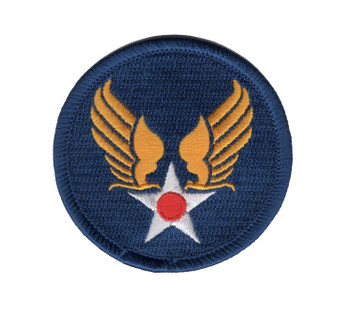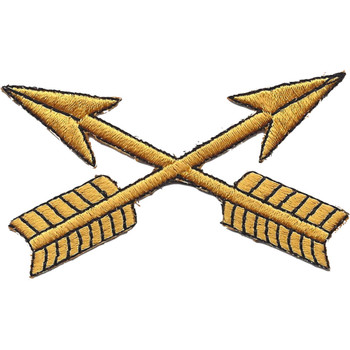Description
Army Air Force Patch Large (U.S. Army) 4.0" x 4.0" Embroidered Patch with Iron-On Backing
Superior Materials: Made with premium polyester thread and durable twill fabric, ensuring long-lasting color and strength.
Advanced Embroidery Technology: Crafted using the most advanced embroidery machinery, guaranteeing intricate detail, sharp lines, and consistent quality every time.
Easy Iron-On Application: Features a heat-activated adhesive backing for quick, no-sew attachment. Simply position, iron, and press for a secure bond.
Versatile Use: Perfect for personalizing jackets, backpacks, uniforms, or any fabric surface that needs a touch of personality.
Durable and Washable: Designed to withstand everyday wear and occasional washing without fading or fraying.
Formations & Origins
The Army Air Forces (AAF) patch represents the proud heritage of American air power before the establishment of the independent United States Air Force in 1947. This emblem, often referred to simply as the “Army Air Forces patch,” was worn by personnel serving in the aerial warfare branch of the U.S. Army during World War II. The AAF itself was officially formed on June 20, 1941, as the successor to the U.S. Army Air Corps, created to centralize and empower America's burgeoning air arm during a time of growing global conflict.
The patch is a large circular insignia featuring a white star centered in a blue disc, with a red roundel in the middle of the star, and stylized golden wings extending from either side. The emblem was designed to convey speed, vigilance, and striking power, and quickly became one of the most recognized military symbols of World War II. It marked not just a branch, but a revolution in military doctrine—the elevation of air power to a decisive role in modern warfare.
Notable Commanders
The most iconic figure associated with the Army Air Forces is General Henry “Hap” Arnold, who served as Commanding General throughout World War II. A visionary leader and advocate of air supremacy, Arnold was the only U.S. Air Force officer ever to hold five-star rank in two branches: as General of the Army and later as General of the Air Force. Under his command, the AAF grew from a modest pre-war force into the largest, most advanced air armada the world had ever seen.
Other notable AAF leaders included General Carl A. Spaatz, who commanded air forces in North Africa, Europe, and later the strategic bombing campaign against Germany. General Jimmy Doolittle, famous for leading the Doolittle Raid over Tokyo in 1942, also commanded the Eighth Air Force during the critical bombing campaigns in Europe. These leaders reshaped air strategy and forged the identity that the Air Force carries to this day.
Major Campaigns/Operations
The Army Air Forces were central to nearly every major American military campaign during World War II. In Europe, the AAF spearheaded the strategic bombing of Nazi Germany, flying from bases in England as part of the Eighth Air Force, and later from Italy with the Fifteenth Air Force. These daylight raids targeted industrial centers, rail hubs, and military installations, though they came at tremendous cost in both aircraft and aircrew.
In the Pacific Theater, the AAF played a pivotal role in island-hopping campaigns and in the final aerial offensive against Japan. The Twentieth Air Force, using B-29 Superfortresses, carried out long-range bombing raids from bases in the Marianas, culminating in the firebombing of Tokyo and, ultimately, the atomic bomb missions over Hiroshima and Nagasaki.
The AAF also provided close air support during the D-Day invasion, North African campaigns, and the liberation of the Philippines. Air transport, reconnaissance, paratrooper drops, and medevac flights all fell under the vast responsibilities of the Army Air Forces, making them a multi-role force long before the term existed.
Specialized Role/Equipment
The Army Air Forces were pioneers in developing specialized aircraft and roles to dominate the air. Fighters like the P-38 Lightning, P-47 Thunderbolt, and P-51 Mustang escorted bombers deep into enemy territory. Bombers such as the B-17 Flying Fortress, B-24 Liberator, and B-29 Superfortress delivered massive payloads over strategic targets.
In addition to combat aircraft, the AAF utilized cargo planes like the C-47 Skytrain to transport troops and supplies across continents and front lines. The AAF also led innovations in radar, navigation, high-altitude flying, and aerial gunnery, and they established rigorous training programs to supply the hundreds of thousands of aircrew and ground support personnel needed to sustain global operations.
The size and complexity of the AAF during WWII were staggering—it operated over 80,000 aircraft and had more than 2.4 million personnel by war’s end.
Acts of Heroism
Acts of heroism by Army Air Forces personnel are legendary. From bomber crews who flew through clouds of flak and enemy fighters over Germany to transport pilots who delivered supplies under fire in Burma, the bravery of AAF airmen was constant and extraordinary.
One of the most famous acts came from the men of the Doolittle Raid in April 1942. Launching B-25 bombers from the USS Hornet—a feat never before attempted—these men struck the Japanese home islands in a daring raid that lifted American morale and shocked the enemy.
Countless Medal of Honor recipients came from the AAF, including 2nd Lt. David R. Kingsley, who gave up his parachute to save a wounded crewman over Europe, and Lt. Col. Leon Vance, who, despite a shattered foot and a dying aircraft, directed a bombing run and saved his crew before his plane crashed into the sea.
Heroism wasn’t limited to pilots—ground crews worked tirelessly, often under enemy attack, to keep aircraft flying. Radar operators, weather forecasters, and logistics specialists played unsung but vital roles in mission success.
Legacy & Notable Achievements
The Army Air Forces laid the foundation for the modern United States Air Force. Its experience in WWII demonstrated that air power was not just a support function but a strategic instrument capable of winning wars. This realization led to the National Security Act of 1947 and the creation of the U.S. Air Force as a separate branch of the military.
The legacy of the AAF lives on in every Air Force squadron patch, in every flight crew trained in the tradition of those who flew into enemy fire, and in every aircraft that takes to the skies in defense of the nation. The large Army Air Forces patch remains a symbol of a transformative period in military history, when flight went from auxiliary role to dominant force.
To wear the AAF patch is to connect with a heritage of daring innovation, global reach, and unshakable resolve in the face of overwhelming odds. It is the symbol of the generation that took to the skies and changed the world forever.






